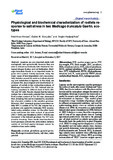Mostrar el registro sencillo del ítem
Physiological and biochemical characterization of rootlets response to salt stress in two Medicago truncatula Gaertn. ecotypes
| dc.creator | Amouri, Adel Amar | es_ES |
| dc.creator | González García, Esther | es_ES |
| dc.creator | Aoul, Seghir Hadjadj | es_ES |
| dc.date.accessioned | 2020-02-12T09:59:50Z | |
| dc.date.available | 2020-02-12T09:59:50Z | |
| dc.date.issued | 2018 | |
| dc.identifier.issn | 1881-6754 | |
| dc.identifier.uri | https://hdl.handle.net/2454/36230 | |
| dc.description.abstract | Legumes are very important plants both ecologically and agriculturally because they are able to interact symbiotically with rhizobia for biological nitrogen fixation and soil fertilization. Medicago truncatula Gaertn. is an important model legume rich in protein. Salinity represents, today, the major cause of land degradation and crop productivity limitation around the world and affects physiology and metabolism in legumes. In this study, we analyzed the physiological and biochemical responses of rootlets in two contrasting ecotypes of Medicago truncatula (Tru 131, tolerant and Jemalong, sensitive) to different level of NaCl, (68, 102 and 137 mM). Results showed that the tolerant ecotype has a lower water potential than Jemalong. Root protein content of Tru 131 was decreased than Jemalong, this can be explained by accumulation of protein oxidation in the sensitive genotype. Moreover, NaCl increased guaiacol peroxidase activity GPX in rootlets of Tru 131, this enzyme has a protective role against the molecules ROS accumulated during oxidative stress. On the other hand, under salt stress the total content of ascorbate (ASC + DHA) and Glutathione (GSH + GSSG) was increased in the tolerant genotype Tru 131 compared to Jemalong. These results show how the tolerant genotype activate the antioxidative defense system at root level against damages caused by oxidative stress under salinity. | en |
| dc.description.sponsorship | This work was financed by the Francophone University Agency (AUF). | en |
| dc.format.extent | 10 p. | |
| dc.format.mimetype | application/pdf | en |
| dc.language.iso | eng | en |
| dc.publisher | Japanese Society for Root Research | en |
| dc.relation.ispartof | Plant Root 12:1-10 | en |
| dc.rights | © 2018 Plant Root (Japanese Society for Root Research) | en |
| dc.subject | Ascorbate | en |
| dc.subject | Glutathione | en |
| dc.subject | Guaiacol peroxidase | en |
| dc.subject | Medicago truncatula Gaertn. | en |
| dc.subject | Salt stress | en |
| dc.subject | Water potential | en |
| dc.title | Physiological and biochemical characterization of rootlets response to salt stress in two Medicago truncatula Gaertn. ecotypes | en |
| dc.type | info:eu-repo/semantics/article | en |
| dc.type | Artículo / Artikulua | es |
| dc.contributor.department | Ciencias del Medio Natural | es_ES |
| dc.contributor.department | Natura Ingurunearen Zientziak | eu |
| dc.rights.accessRights | info:eu-repo/semantics/openAccess | en |
| dc.rights.accessRights | Acceso abierto / Sarbide irekia | es |
| dc.identifier.doi | 10.3117/plantroot.12.1 | |
| dc.relation.publisherversion | https://doi.org/10.3117/plantroot.12.1 | |
| dc.type.version | info:eu-repo/semantics/publishedVersion | en |
| dc.type.version | Versión publicada / Argitaratu den bertsioa | es |


